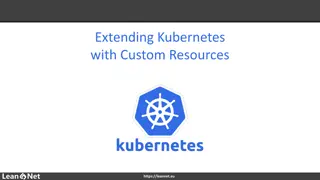Genetic Programming Tree Implementation for Pac-Man Controllers
Implementation of genetic programming tree for Pac-Man controllers involves methods like random search through parse tree space, full genetic programming recombination, mutation, and competitive co-evolution. The setup includes defining the problem formulation, scoring function represented as a tree, and evaluation based on final game score.
Download Presentation

Please find below an Image/Link to download the presentation.
The content on the website is provided AS IS for your information and personal use only. It may not be sold, licensed, or shared on other websites without obtaining consent from the author.If you encounter any issues during the download, it is possible that the publisher has removed the file from their server.
You are allowed to download the files provided on this website for personal or commercial use, subject to the condition that they are used lawfully. All files are the property of their respective owners.
The content on the website is provided AS IS for your information and personal use only. It may not be sold, licensed, or shared on other websites without obtaining consent from the author.
E N D
Presentation Transcript
Genetic Programming Tree Implementation for Pac-Man Controllers Deacon Seals Modified from slides by Josh Wilkerson
Assignment Series 2 Roadmap Assignment 2a: Random Search Through Parse Tree Space Ramped Half-And-Half Grow method Full method Print trees as strings Tree execution Assignment 2b: Full Genetic Programming Recombination Mutation Modified child_generation Recall that recombination and mutation are exclusively separate methods for generating a child Assignment 2c: Competitive Co-Evolution Tweak your Pac-Man genotype to evolve Ghosts (with slightly different sensors) Co-evolve populations for each controller type and perform competitive fitness evaluations
Pac-Man starts in the top left cell Ghosts start in the 3 remaining corners Units can move up, down, left, and right Pac-Man can also hold position, but ghosts can t Simplified Pac-Man All units move at the same time Units can t move off the edge Ghosts may occupy the same cell as each other If Pac-Man swaps locations with a ghost or occupies the same cell, the game ends The game also ends if the timer expires or if all pills are consumed Visualizer
The Setup Problem Formulation Current state ? Locations of pills, players, fruit, and walls All valid actions ? ? ? Known state transition ? ? ? Find a function ?(? ) that assigns a value/score We want to evolve this! Select the action that produces either the highest or lowest value Experiment and find out which greedy policy performs better The agent is assessed based on the final score of the game
The Setup The Scoring Function Will be represented as a tree (hence the GP) Depth first, in-order traversal Operator nodes: + - * / MIN MAX (RAND) Sensor input nodes: Distance to nearest ghost - G Distance to nearest pill - P Distance to nearest fruit - F Number of adjacent walls - W Constant float value - #.# Note: this isn t a singular global value, but an ephemeral constant See assignment material for official list of primitives! Represents the function V(State) = (1.2 / G) * MIN(W, P)
The Scoring Tree: Nodes Nodes in the tree Represent atomic components of the scoring function Also called primitives Nodes will need to have An associated primitive A place to store a value A place to store children of the node Node Primitive Communicates what the node does G, P, W, F, and #.# are leaf (sensor) nodes +, -, *, /, etc. are internal (operator) nodes
The Scoring Tree: Nodes Node Value This is only used if the node is a #.# (ephemeral constant) node Will contain the value for numeric nodes Node Children This is only used if the node is an internal node The children are the operands for this node All of our internal nodes have two operands Left and right children
Tree Initialization Basic Tree Initialization Approach Select a random primitive for the current node If node is an operator, recursively generate values for its children If the node is a sensor, it has no children Grow Initialization Method Nodes above the depth limit are randomly assigned a primitive that can be operator or sensor Nodes at the depth limit are sensors Generates sufficiently random trees with bounded depth Full Initialization Method Nodes above the depth limit are randomly assigned operator primitives Nodes at the depth limit are sensors Generates full trees with uniform depth
The Scoring Tree: Execution Ok, so we have a scoring tree, how do we get a score from it? Recursion! exec: takes in self and state s, returns a floating point score if self is primitive `plus : return left_child.exec(s) + right_child.exec(s) if self is primitive `minus : return left_child.exec(s) right_child.exec(s) ... if self is primitive `min : return minimum value of left_child.exec(s) and right_child.exec(s) if self is primitive `ghostDist : return ghostDist(s) if self is primitive `pillDist : return pillDist(s) if self is primitive `number : return the value for self Depth first, in order tree traversal pseudocode:
A Note on Environment Interaction State Dictionary with named attributes Walls 2D list with [x][y] indexing state[ walls ][x][y] == True if wall exists else False Pills frozen set of coordinate tuples corresponding to pill locations Fruit coordinate tuple if fruit exists otherwise None Players dictionary of player-name : coordinate-tuple pairs state[ players ] = {'m': (0, 19), '0': (34, 0), '1 : (0, 0), '2': (34, 19)} Evaluation Game object will provide a list of states corresponding to valid actions You must select the index of the action you would like to make
Other Implementation Details Possible Random Sub-Tree Selection Method Count how many nodes are in a tree Generate a random value between 1 and that number Walk through the tree, counting nodes until you reach the number selected Possible Sub-Tree Crossover Method Create copies of the parents Randomly select a sub-tree from one parent copy Replace a sub-tree in one copy with the sub-tree selected from the other
Other Implementation Details Possible Sub-Tree Mutation Methods Randomly change the node type Changing from internal node to leaf node Just trim off current children Changing from leaf node to internal node Have to generate random child nodes Randomly select node type, generate operands (children) if necessary Recursion may be useful here Randomly change node value Only applicable to number nodes Possible Parsimony Penalty Methods to Battle Tree Bloat Penalize the number of nodes a tree has Penalize the total height of a tree can Always bound tree height in these assignments!
Advice For Assignment 2a Implement Tree Generation First Populate tree type and ignore execution at first Print trees and use the tree checker tool Test Execution With Single-Node Trees Sensor input primitives are a likely place for failure Operator primitives are easier Don t forget about division by zero though Dynamic Programming Can Make Agent Execution Much Faster Two instances of the same sensor typically return the same value for a given state Don t Dev Yourself Into A Corner Assignment series 2 is more open-ended Keep recombination and mutation in mind
Distance Calculations: Manhattan Distance Distance as if one were walking city blocks (ignoring walls) ???? ?????= ?0 ?1+ ?0 ?1 ???? ?????= 0 2 + 0 2 4 3 2 1 0 0 1 2 3 4
Distance Calculations: Breadth-First Graph Search Shortest path from source to destination (considering walls) Add adjacent spaces to an exploration frontier (queue) to visit Don t add spaces already on the frontier or already visited (distinct from BF Tree Search) 4 3 2 1 0 0 1 2 3 4
Distance Calculations: Breadth-First Graph Search Shortest path from source to destination (considering walls) Add adjacent spaces to an exploration frontier (queue) to visit Don t add spaces already on the frontier or already visited (distinct from BF Tree Search) 4 3 2 1 F 0 F Frontier:{(0,1), (1, 0)} Visited: {} 0 1 2 3 4
Distance Calculations: Breadth-First Graph Search Shortest path from source to destination (considering walls) Add adjacent spaces to an exploration frontier (queue) to visit Don t add spaces already on the frontier or already visited (distinct from BF Tree Search) 4 3 2 1 V 0 F Frontier:{(1, 0)} Visited: {(0, 1)} 0 1 2 3 4
Distance Calculations: Breadth-First Graph Search Shortest path from source to destination (considering walls) Add adjacent spaces to an exploration frontier (queue) to visit Don t add spaces already on the frontier or already visited (distinct from BF Tree Search) 4 3 2 1 V 0 V F Frontier:{(2,0)} Visited: {(0, 1), (1, 0)} 0 1 2 3 4
Distance Calculations: Breadth-First Graph Search Shortest path from source to destination (considering walls) Add adjacent spaces to an exploration frontier (queue) to visit Don t add spaces already on the frontier or already visited (distinct from BF Tree Search) 4 3 2 1 V 0 V V F Frontier:{(3,0)} Visited: {(0, 1), (1, 0), (2,0)} 0 1 2 3 4
Distance Calculations: Breadth-First Graph Search Shortest path from source to destination (considering walls) Add adjacent spaces to an exploration frontier (queue) to visit Don t add spaces already on the frontier or already visited (distinct from BF Tree Search) 4 3 2 1 V F 0 V V V F Frontier:{(3, 1), (4,0)} Visited: {(0, 1), (1, 0), (2,0), (3,0)} 0 1 2 3 4
Distance Calculations: Breadth-First Graph Search Shortest path from source to destination (considering walls) Add adjacent spaces to an exploration frontier (queue) to visit Don t add spaces already on the frontier or already visited (distinct from BF Tree Search) 4 3 2 F 1 V V F 0 V V V F Frontier:{(4,0), (3,2), (4,1)} Visited: {(0, 1), (1, 0), (2,0), (3,0), (3, 1)} 0 1 2 3 4
Distance Calculations: Breadth-First Graph Search Shortest path from source to destination (considering walls) Add adjacent spaces to an exploration frontier (queue) to visit Don t add spaces already on the frontier or already visited (distinct from BF Tree Search) 4 3 2 F 1 V V F 0 V V V V Frontier:{(3,2), (4,1)} Visited: {(0, 1), (1, 0), (2,0), (3,0), (3, 1), (4,0)} 0 1 2 3 4
Distance Calculations: Breadth-First Graph Search Shortest path from source to destination (considering walls) Add adjacent spaces to an exploration frontier (queue) to visit Don t add spaces already on the frontier or already visited (distinct from BF Tree Search) 4 3 2 F V F 1 V V F 0 V V V V Frontier:{(4,1), (2, 2), (4, 2)} Visited: {(0, 1), (1, 0), (2,0), (3,0), (3, 1), (4,0), (3,2)} 0 1 2 3 4
Distance Calculations: Breadth-First Graph Search Shortest path from source to destination (considering walls) Add adjacent spaces to an exploration frontier (queue) to visit Don t add spaces already on the frontier or already visited (distinct from BF Tree Search) 4 3 2 F V F 1 V V V 0 V V V V Frontier:{(2, 2), (4, 2)} Visited: {(0, 1), (1, 0), (2,0), (3,0), (3, 1), (4,0), (3,2), (4,1)} 0 1 2 3 4
Distance Calculations: Breadth-First Graph Search Shortest path from source to destination (considering walls) Add adjacent spaces to an exploration frontier (queue) to visit Don t add spaces already on the frontier or already visited (distinct from BF Tree Search) 4 3 2 Goal! V F 1 V V V ?? ?????? ??? = 6 0 V V V V 0 1 2 3 4























